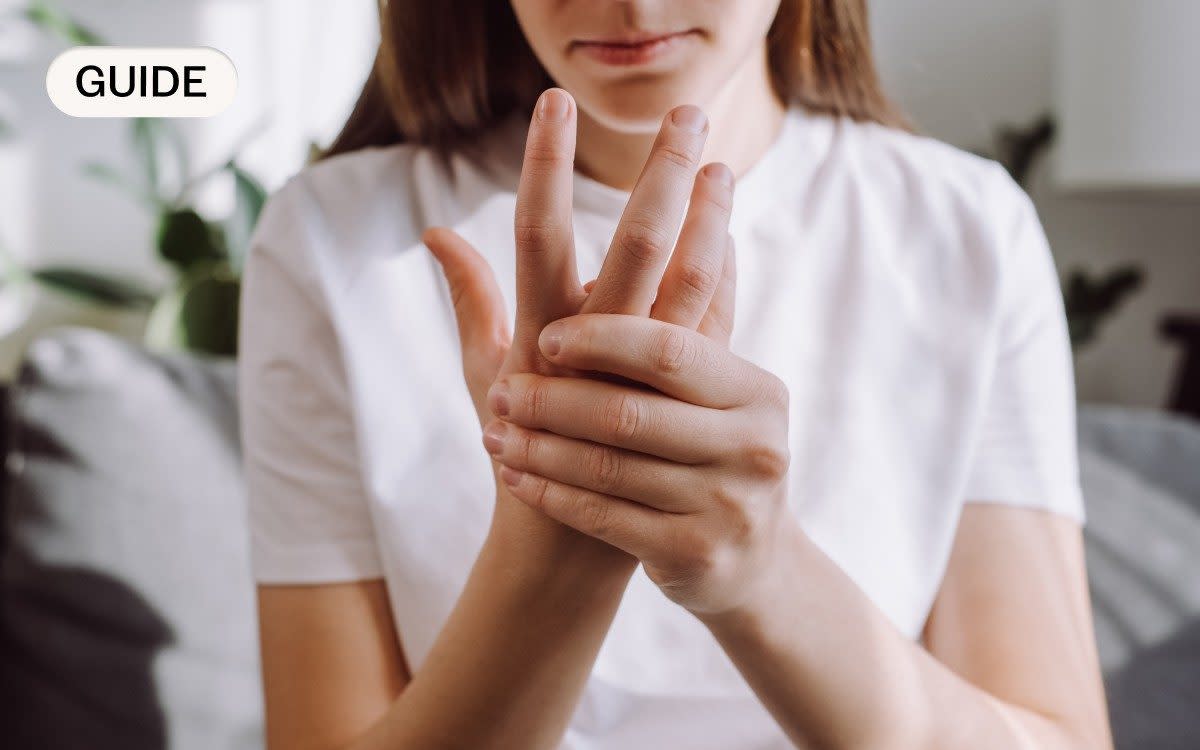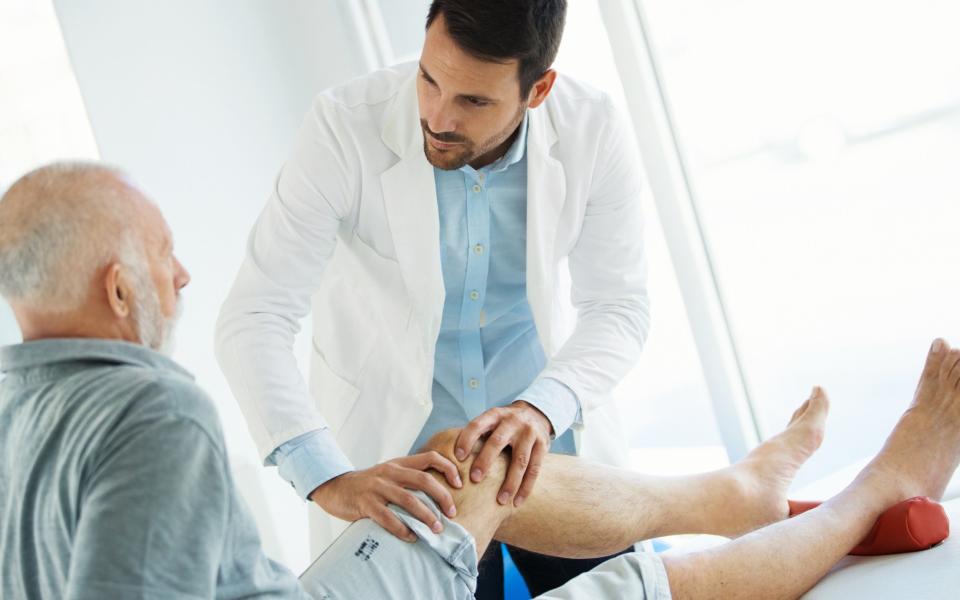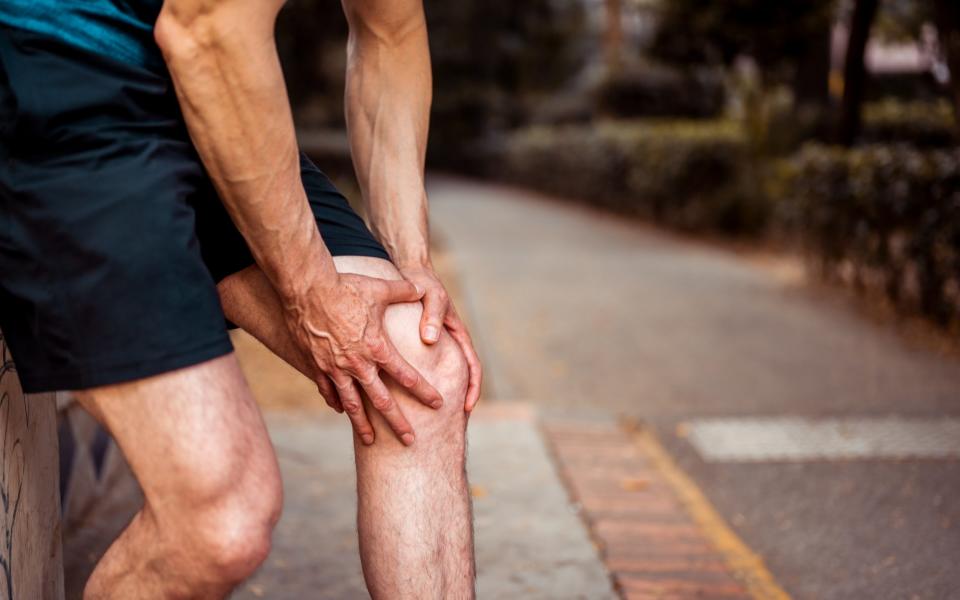Arthritis and joint pain – the symptoms to know about and how to treat it

For many of us, aches and pains, sore joints and stiffness are an everyday fact of life. But how can we tell whether they are signs of something more serious, such as arthritis?
About half of us by the age of 70 will have a form of arthritis, while some are affected much younger. Osteoarthritis is the most common type of the condition, mainly affecting the joints, with 73 per cent of people with the condition older than 55. Rheumatoid arthritis, an autoimmune and inflammatory disease, is the second most prevalent disease, affecting nearly half a million in the UK.
“I often hear people saying, ‘it’s just a bit of arthritis’”, says Dr Benjamin Ellis, a consultant rheumatologist and senior clinical policy advisor to charity Versus Arthritis. “But if you have any joint pain or stiffness that’s interfering with your quality of life then it’s important to talk to your GP. The longer you leave it, the harder it is to treat.”
Here are the symptoms and latest treatments you need to know about, and the ways you can reduce your risk.
What exactly is arthritis?
Arthritis is a condition that causes pain, swelling and stiffness in joints and the surrounding tissues. There are several different types which can affect people of all ages, including children and teenagers. Research indicates that 60 per cent of sufferers are female. The condition is more common with age.

Any joint can become arthritic, but the most commonly affected areas of the body are the knees, hands, hips, feet and lower back. Although there’s no cure, there are several different treatment options, including a groundbreaking new drug trial for rheumatoid arthritis which claims to cut the chance of developing the disease by 80 per cent. Some types of arthritis can be put into remission.
If you’ve ever wondered about the difference between arthritis and rheumatism, then it’s simply a matter of terminology. “Rheumatism is a bit of an old-fashioned word that describes pain in the musculoskeletal system, either from the joints or the tissues surrounding the joints,” explains Professor John Axford, a consultant in adult and paediatric rheumatology and emeritus professor of clinical rheumatology at St George’s University Hospitals.
What are the different types of arthritis?
“Broadly speaking, there are two sorts of arthritis,” explains Dr Ellis. “The most common type is osteoarthritis (OA), which is a condition where joints are no longer able to fully repair and heal themselves from the daily knocks we put them through. An estimated 8.75 million people in the UK have consulted their GP about their symptoms, according to the charity Versus Arthritis.
“When we’re young, we’re constantly rebuilding the cartilage – the smooth, shiny stuff on the end of bones – and we need that for joints to work well. In about half of us, by age 70, we’ll have osteoarthritis where that smooth casing of cartilage has become more uneven, rougher, and sometimes depleted. The body tries to repair it but doesn’t do a very good job, and that can make joints stiff, painful and sometimes inflamed.” Osteoarthritis typically develops from the age of around 45, although younger people can also be affected. This is known as early-onset osteoarthritis.
The second most prevalent form of arthritis is an autoimmune disease, most commonly rheumatoid arthritis (RA). “Here, the immune system is out of balance and instead of being our natural self defence, it’s turning on the body and attacking joints and the tissues around them,” says Dr Ellis, “making them painful, swollen and stiff”.
Rheumatoid arthritis can affect people of any age, but typically appears between the ages of 40 to 60. Research from Nice indicates that it’s the most common form of inflammatory arthritis, with about 1 per cent of the UK population affected. It’s up to four times more common in women than men.
Arthritis symptoms: what does it feel like?
Arthritis symptoms vary and change over time, but there are a few key things to look out for. One of the main symptoms is joint pain and stiffness which is worse first thing in the morning, but eases once you get up and about.
Dr Ellis says: “The symptoms which suggest arthritis are pain, stiffness, and difficulty moving the joint – perhaps because it has become restricted in some way. You may also notice swelling which might be hard, bony and knobbly, or could be soft. Joints can also become hot and red and change shape.” He adds: “Pain that wakes you during the night, pain that affects more than one joint, and pain that is worse in the morning and lasts for more than 30 minutes after you get up can be suggestive of the autoimmune type of arthritis.
“If you have these symptoms it’s important to take urgent action rather than just taking some ibuprofen and waiting to see how things go for the next few weeks. Ask your doctor for a referral as the sooner you can get the immune system back in balance, the less intensive treatment you are likely to need.”
How to cope with arthritis: best treatment options
There’s no current cure for arthritis, but there are treatment options that can help to manage it, or potentially prevent some forms, including a new drug trial which has shown the potential to cut the chance of developing rheumatoid arthritis by 80 per cent. Weekly injections of the drug Abatacept were shown to help reduce the activity of the immune system, preventing the body from attacking itself.
Inflammatory forms of arthritis, such as rheumatoid arthritis, require medication to bring the immune system back into balance.
There are also several different types of drugs that can help, including a ‘disease-modifying drug’ (DMARD) such as methotrexate, sulfasalazine or hydroxychloroquine, along with steroids and anti-inflammatories.
Professor Axford says: “The beautiful thing about advances in rheumatology is that there are a whole range of drugs that are available that can pharmaceutically ‘cure’ rheumatoid arthritis. If you can stay in remission for about two years, then it’s possible to reduce the dosage and sometimes we can successfully take patients off all medications.”
If you have osteoarthritis, “initially you might take medicine such as codeine or ibuprofen,” says Dr Ellis, “but you’re taking those to control pain not to prevent damage. If your osteoarthritis doesn’t respond to lifestyle changes, such as being a healthy weight and exercising, then your doctor might suggest steroid joint injections to reduce inflammation and relieve pain and stiffness. Some people will go on to have a joint replacement. There are about 100,000 hip and knee replacements performed in England each year and they are almost all for osteoarthritis.”
How to prevent arthritis, the natural way
Aside from medication, there are lifestyle changes that can help to reduce your risk.
Dr Ellis says: “Don’t smoke; drink alcohol in moderation, if at all; keep physically active; maintain a healthy weight; eat a healthy diet and do your best to avoid highly-processed foods.”
If you have a physical job, it’s wise to take precautions to protect your joints and avoid injuries as research indicates that heavy physical work including prolonged kneeling, regular stair climbing, crawling, bending, whole body vibration and repetitive movements are common occupational risk factors for osteoarthritis. Exercising regularly can help to improve your fitness and strength, which not only helps to strengthen and stabilise the joints but also improves blood flow to the surrounding tissues which aids repair.
What are the main causes of arthritis?
Experts still aren’t entirely clear on the complex range of reasons that can trigger the condition. So far, research has identified three main risk factors:
Age: The older you are, the more likely you are to have arthritis
Gender: Women are more likely to be affected than men
Genetics: Some types of arthritis are linked to certain genes
Dr Benjamin Ellis says, “When talking about osteoarthritis we try to avoid talking about ‘wear and tear’ as that doesn’t accurately reflect the biological process involved. We’re only just beginning to understand some of the chemical processes that cause the joint to become less intact.
“A previous injury can predispose you to arthritis, as joints which are unstable are more likely to develop osteoarthritis. Poor metabolic health (type 2 diabetes, high cholesterol and high blood pressure) seems to accelerate osteoarthritis, and if you have obesity you’re two to four times more likely to be affected. There’s also likely to be a genetic link, as half of us will get to 70 without developing arthritis, and we don’t yet understand why. If you have a parent who developed osteoarthritis in their 50s, there’s a reasonable chance that you will develop it too.”
It’s not yet known what triggers rheumatoid arthritis, but research suggests that it’s caused by a combination of genetics, hormones and environmental factors. For example, one study found that the risk of developing rheumatoid arthritis was twice as high for smokers compared to non-smokers.
How can I manage my arthritis pain?
“We know that movement and exercise helps, but this is hard for people to hear when they are in agony,” says David Vaux, the head of therapy, exercise and training at Arthritis Action. Christine Simms, a psychotherapist and founder of The Mind-Body Guide, agrees. She says, “I tell my clients that ‘motion is lotion’, because our body produces a lubricating fluid called lubricin, which is like WD-40 for the joints. It’s refreshed and replenished every day, and when you move it passes through the joints, reducing stiffness and supporting ease of movement.”

Many people with arthritis also take painkilling drugs. Professor Axford says: “Painkilling drugs like co-codamol and paracetamol, and anti-inflammatories such as ibuprofen can help relieve pain and swelling. It’s important to use these appropriately and sparingly, as if you’re taking medication seven days per week, four weeks per month, you’re going to get side effects such as stomach problems. I advise patients to take the medication for five in seven days if they need to, and give themselves a week or two break when they can.”
Are there any home remedies or good supplements for arthritis?
“Losing excess body fat and maintaining a healthy BMI is one of the most foundational things you can do to improve any joint pain,” David Vaux advises. “Losing one pound of body fat equates to four pounds less loading across the knee joints. So if you lose 10 pounds that’s the equivalent of taking a 40 pound rucksack off your back, which is a huge benefit to your knees, hips, feet and lumbar spine.”
Some people claim that nutritional supplements can also be helpful, particularly omega-3, collagen, glucosamine and chondroitin. Jane Hutton, a consulting clinical nutritionist and chef at The Functional Foodie, says, “Reducing inflammation is key for both osteoarthritis and rheumatoid arthritis. I recommend krill oil which is a full-spectrum, high-quality omega supplement, but these should be avoided if you take blood thinners. Glucosamine and chondroitin are commonly taken for joints and seem to have some benefit on joint integrity and pain management. Collagen is derived directly from amino acids, so it’s good for ensuring the building blocks are there for all kinds of tissue production and integrity. It’s also anti-inflammatory, so can be useful for rheumatoid as well as osteoarthritis.”
Hutton adds, “SAM-e (S-Adenosylmethionine) is the supplement of choice for osteoarthritis, as it directly helps joints and is backed by research. However, research on supplements is mixed, so the results are not clear cut when it comes to efficacy.” Indeed, while research suggests that SAM-e can help with pain management in osteoarthritis, it can also cause severe anxiety and mania in people who suffer from depression, so it’s important to consult your doctor before taking any supplements.
David Vaux says: “We live in an exciting time because more discoveries are coming through every day, but I don’t think any of these supplements have been absolutely proven. I wouldn’t spend money at this stage but if the evidence arrives I’ll be the first on the bandwagon.”
What are the best exercises to help with arthritis symptoms?
“One of the best things you can do for any form of arthritis is strengthen and mobilise the joint,” explains David Vaux. “Even a couple of sessions of water therapy each week can work wonders, and this is especially important in the build up to surgery as pre-habilitation will help you recover much more quickly.”
Dr Ellis says, “Start with what feels manageable, listen to your body and build up gradually. If you’re a bit achy the day after, that’s normal. If you’re in agony during the exercise, please stop. If you’re in agony the next day, take a break but go back and do less, and build up more gradually.”
Depending on your level of fitness and mobility, experts agree that the best kind of exercise is the one that you enjoy, whether that’s walking, swimming, fitness classes or strength training. If this sounds daunting, Simms recommends the following exercises which you can build into your daily routine to get you started. Start slowly, with one or two repetitions each day, and gradually increase.
For shoulders
“When you’re lying on your back in bed, stretch one arm up to the ceiling and imagine that you’re drawing circles on the ceiling. Start small and make the circles bigger. Afterwards, take your arm up behind your back, aiming to reach between your shoulder blades. Then take it up over your head and try to reach down between your shoulder blades from the opposite direction. Do this on both sides.”
For hands and fingers
“All kinds of craft activities from knitting and crochet to jigsaw puzzles, card games and Lego can help improve mobility. Holding arms flat and rotating the wrists to turn the palm up and down is also beneficial.”
For knees
“Before you get out of bed in the morning, sit up against your pillows with your legs out flat in front of you, then bring one heel up towards your bottom, then straighten your leg as much as you can and flex your foot. You need to do this with both legs, even if only one knee is affected.”
For hips
“Build on the exercise above by putting your hands around your knee when you bring your heel up towards your bottom and gently move it round in circles, first in one direction and then the other.”
For ankles
“When you’re lying in bed or sitting in a chair, try to draw a circle with your foot, making the circle as big as you can. Remember to do this both clockwise and anticlockwise.”
For feet
“When sitting in a chair, roll a tennis ball around underneath your bare feet. Really work on curling your toes over the ball to move it around, then spread them out wide. This is a great way to improve mobility in the feet.”
Could other lifestyle changes help with my arthritis?
A healthy lifestyle can help to manage arthritis symptoms, so it’s important to pay attention to your diet and make sure you’re getting enough sleep. Research indicates that the Mediterranean diet, made up of fish, fresh fruit and vegetables, nuts, legumes, olive oil and avocados can have anti-inflammatory benefits, which reduces osteoarthritis pain.
“If you need to lose weight, avoid crash diets and choose a Mediterranean diet paying attention to portion size,” says David Vaux. “If you need to build strength, increase your protein intake as you need sufficient protein and healthy fats to build muscle.”
Finally, practise good sleep hygiene by keeping devices out of the bedroom, cutting back on caffeine and establishing a bedtime routine. “If you’re not rested and recovered you’re not going to respond to exercise,” explains David Vaux. “When you identify the lifestyle habits that work for your body, and stick to them with consistency, over time the benefits will accumulate and you will develop more strength, more stability, and profound improvements in pain sensitivity.”
What are the other types of arthritis?

Psoriatic arthritis
As well as joint stiffness and inflammation, this can cause a red, scaly rash called psoriasis. It’s more common in people who already have psoriasis, but it’s possible to have psoriatic arthritis with no skin symptoms.
Ankylosing spondylitis
An inflammatory condition that causes pain and swelling, mainly around the joints of the spine.
Gout
A painful type of inflammatory arthritis that causes sudden and severe joint pain, typically in the big toe. It’s caused by a buildup of uric acid in the body, which forms into crystals that are deposited inside the joint. It’s more common in men, and in post-menopausal women.
Cervical spondylitis
Also known as degenerative osteoarthritis, this causes pain and stiffness in the joints and bones in the neck.
Septic arthritis
This is a serious joint infection which occurs when bacteria get into a joint. It can happen as a complication of joint surgery.
Reactive arthritis
This causes joint pain and swelling which appears after an infection, usually food poisoning or a sexually-transmitted infection.
Secondary arthritis
This type of arthritis occurs after a previous joint injury.
Polymyalgia rheumatica
This is an age-related condition which is rare in people under the age of 50. It causes pain and inflammation in the muscles around the shoulders, neck and hips.
Recommended
Health / Conditions / Bones & joints Five ways to tackle the joint pain of arthritis

